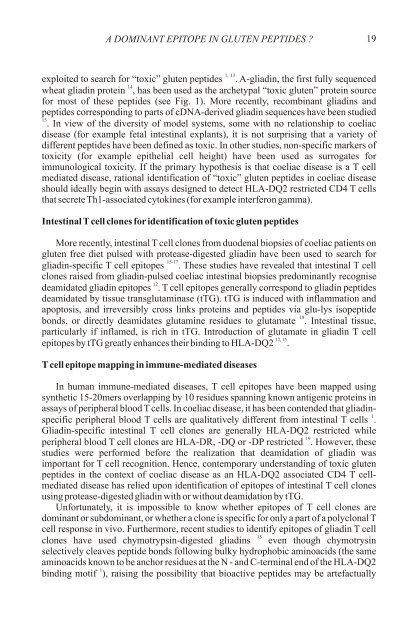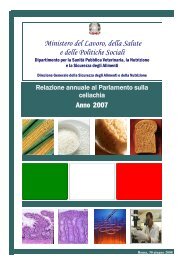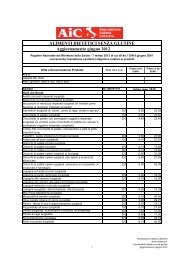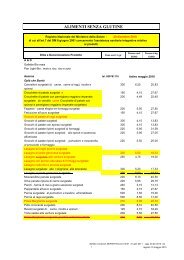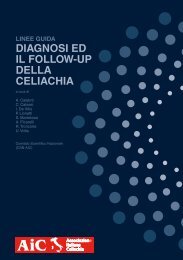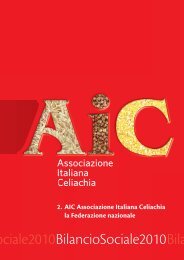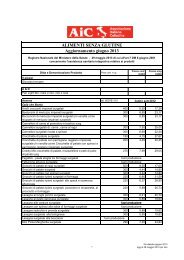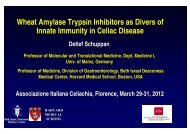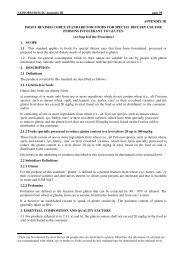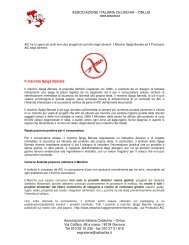primary prevention of coeliac disease - Associazione Italiana ...
primary prevention of coeliac disease - Associazione Italiana ...
primary prevention of coeliac disease - Associazione Italiana ...
Create successful ePaper yourself
Turn your PDF publications into a flip-book with our unique Google optimized e-Paper software.
A DOMINANT EPITOPE IN GLUTEN PEPTIDES ?<br />
19<br />
1, 13<br />
exploited to search for “toxic” gluten peptides . A-gliadin, the first fully sequenced<br />
14<br />
wheat gliadin protein , has been used as the archetypal “toxic gluten” protein source<br />
for most <strong>of</strong> these peptides (see Fig. 1). More recently, recombinant gliadins and<br />
peptides corresponding to parts <strong>of</strong> cDNA-derived gliadin sequences have been studied<br />
15<br />
. In view <strong>of</strong> the diversity <strong>of</strong> model systems, some with no relationship to <strong>coeliac</strong><br />
<strong>disease</strong> (for example fetal intestinal explants), it is not surprising that a variety <strong>of</strong><br />
different peptides have been defined as toxic. In other studies, non-specific markers <strong>of</strong><br />
toxicity (for example epithelial cell height) have been used as surrogates for<br />
immunological toxicity. If the <strong>primary</strong> hypothesis is that <strong>coeliac</strong> <strong>disease</strong> is a T cell<br />
mediated <strong>disease</strong>, rational identification <strong>of</strong> “toxic” gluten peptides in <strong>coeliac</strong> <strong>disease</strong><br />
should ideally begin with assays designed to detect HLA-DQ2 restricted CD4 T cells<br />
that secrete Th1-associated cytokines (for example interferon gamma).<br />
Intestinal T cell clones for identification <strong>of</strong> toxic gluten peptides<br />
More recently, intestinal T cell clones from duodenal biopsies <strong>of</strong> <strong>coeliac</strong> patients on<br />
gluten free diet pulsed with protease-digested gliadin have been used to search for<br />
15-17<br />
gliadin-specific T cell epitopes . These studies have revealed that intestinal T cell<br />
clones raised from gliadin-pulsed <strong>coeliac</strong> intestinal biopsies predominantly recognise<br />
12<br />
deamidated gliadin epitopes . T cell epitopes generally correspond to gliadin peptides<br />
deamidated by tissue transglutaminase (tTG). tTG is induced with inflammation and<br />
apoptosis, and irreversibly cross links proteins and peptides via glu-lys isopeptide<br />
18<br />
bonds, or directly deamidates glutamine residues to glutamate . Intestinal tissue,<br />
particularly if inflamed, is rich in tTG. Introduction <strong>of</strong> glutamate in gliadin T cell<br />
12, 15<br />
epitopes by tTG greatly enhances their binding to HLA-DQ2 .<br />
T cell epitope mapping in immune-mediated <strong>disease</strong>s<br />
In human immune-mediated <strong>disease</strong>s, T cell epitopes have been mapped using<br />
synthetic 15-20mers overlapping by 10 residues spanning known antigenic proteins in<br />
assays <strong>of</strong> peripheral blood T cells. In <strong>coeliac</strong> <strong>disease</strong>, it has been contended that gliadin-<br />
1<br />
specific peripheral blood T cells are qualitatively different from intestinal T cells .<br />
Gliadin-specific intestinal T cell clones are generally HLA-DQ2 restricted while<br />
19<br />
peripheral blood T cell clones are HLA-DR, -DQ or -DP restricted . However, these<br />
studies were performed before the realization that deamidation <strong>of</strong> gliadin was<br />
important for T cell recognition. Hence, contemporary understanding <strong>of</strong> toxic gluten<br />
peptides in the context <strong>of</strong> <strong>coeliac</strong> <strong>disease</strong> as an HLA-DQ2 associated CD4 T cellmediated<br />
<strong>disease</strong> has relied upon identification <strong>of</strong> epitopes <strong>of</strong> intestinal T cell clones<br />
using protease-digested gliadin with or without deamidation by tTG.<br />
Unfortunately, it is impossible to know whether epitopes <strong>of</strong> T cell clones are<br />
dominant or subdominant, or whether a clone is specific for only a part <strong>of</strong> a polyclonal T<br />
cell response in vivo. Furthermore, recent studies to identify epitopes <strong>of</strong> gliadin T cell<br />
15<br />
clones have used chymotrypsin-digested gliadins even though chymotrysin<br />
selectively cleaves peptide bonds following bulky hydrophobic aminoacids (the same<br />
aminoacids known to be anchor residues at the N - and C-terminal end <strong>of</strong> the HLA-DQ2<br />
1<br />
binding motif ), raising the possibility that bioactive peptides may be artefactually


